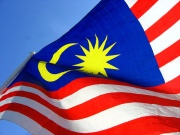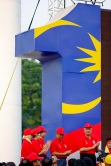At midnight on Aug 30, 1957, millions of Malayans rejoiced the momentous occasion of the nation's father Tunku Abdul Rahman replacing the Union Jack with the Malayan flag.
About 450 kilometres away, deep in a thick jungle at the border of Malaya and Thailand, a smaller band of brothers (read: armed comrades) was huddled in front of a fire, pondering what would that act of lowering the Union Jack mean to them.
Fifty-two years on, they are all bitter that the truth about their role in gaining independence for the country remains unrecognised, and are worried that it would die with them.
This group of men and women – all members of the fearsome 10th Regiment of the Communist Party of Malaya led by Abdullah CD – have been based in this border area since the end of 1953 following a continuous onslaught against them by the British forces.
Numbering about 550 people, these guerrilla fighters had waged a war to get rid of the British since the formation of their regiment on May 21, 1949. They were part of a larger CPM war unit under its Malaya National Liberation Army which had about 8,000 fighters at its peak.
However, with the declaration of Emergency in 1948, the party was banned and for the next 12 years, they were in constant battle with the authorities (first the British, then the Malayans with the help of the British) who were adamant about getting rid of the communist guerrillas.
 | The resulting offensive drove many communist guerrillas into the Thai-Malaysian border, where the subsequent Malaysian government continued their attacks until a peace deal was struck in 1989.
By 1989, the strength of the CPM had dwindled and following the peace agreement, they settled in four 'peace villages' in southern Thailand. What remains now is a history in the perspective of the victors where these CPM guerrilla's are demonised as terrorists.
In view of the nation's 52nd Merdeka, Malaysiakini recently visited one such communist 'peace village' in Sukhirin, southern Thailand, to talk to some of these battle-hardened "communist insurgents" on their role in gaining independence.
The village – Kampung Chulaborn 12 – is home to about 460 people, made of the families and extended family members of the original Regiment 10 members. It had about 260 people – mostly ex-communist members – when it was established in 1989. Today, the remaining war veterans include Abdullah CD, his wife Suriani Abdullah and about 20 of his comrades.
People were suffering under the British
The 10th Regiment was established in Temerloh by Abdullah CD and as such most of its members had come from Temerloh and other parts of Pahang.
 | One of them is Shukor Ismail, now 80, who was taken in by the communist ideology in 1948 and was a pioneer member of Regiment 10.
"At that time the people suffered under the British rule. We had just come out of the Japanese occupation, which was also a painful period. Many had already started feeling that we did not need the British to rule us," he recounted outside his attap house in the peace village.
"The farmers were feeling the economic pinch as they were not getting enough. It seemed as though all our hard work and money was being shipped off to London for the empire.
"I started my war against them because of this – they took what's mine to enrich themselves," said Shukor, whose body was clearly showing the evidence of hardship it had undergone.
He added that the people of Temerloh had an early start in nationalism as a result of the anti-British war initiated by Dato Bahaman in 1891 to 1895.
"His failure was the key to our struggle. The descendants of Dato Bahaman in Temerloh always knew that we had to get rid of the British and we managed to do that with CPM and our regiment."
 | Shukor also had no doubt over the role played by his comrades in freeing this nation from the occupiers.
"This was our revolution and we were successful, despite what the rulers of Malaysia say today.
"It was our campaign which brought about the change in the mindset of the people that they could self-rule and that they could chart their own future without any outside interference.
"What had the others done actually? They were colluding with the British. And now they are denying us of our role," he said with a tinge of anger in his voice.
'We drove them away'
Shukor went on to say that it was a falsehood to state that Malayan independence was gained without shedding a drop of blood.
"That makes no logic at all for the politicians to say we gained our independence peacefully. For me, the price of independence came with our blood being shed.
"We drove the British away. They left because they couldn't outwit us in jungle warfare and they were defeated as they knew they could never stop us from attacking them. They did not want to continue with that burden so they handed the country to Umno, knowing that the armed struggle would be between Malayans after that.
 | "And even when they gave the country to Umno, the British were still holding much influence, be it in security matters or in financial matters. They were also reaping the benefits of our economy," he added.
He said that it was never the intention of the communist to fight among Malayans. The enemy was the British and "their stooges", he added.
"I'm sad that the people in Malaysia today are unaware of this truth. They only believe in what has been told to them by the present rulers, who find it suitable to give prominence to whatever role they played in getting the independence.
"The present government is still living in that lie. It's in the history books, it's in their national monument… look at Tugu Negara. What do you see? You see British soldiers kicking local fighters. That does not reflect the correct historical fact," said the former guerrilla who spent 40 years in jungle.
 | He also added that he felt independence was not fully attained by the people of Malaysia as "the residues of British rule are still prevalent in our system".
"When it comes to political power in the nation, it is still a leftover of the British concept of race-based rule. Are the people fully empowered to do what they want for the nation? Is everyone equal in Malaysia today?
"What is different from the British divide-and-rule policy? Economically, is everyone well-to-do? Who is controlling the economy? Just like the British period, it is still in the hands of a group of people, not with the rakyat," he noted.
The victor's version is skewed
This was a point which was agreed to by his colleague Awang Yaakob, a former team leader of the 10th Regiment.
 | The 67-year-old born in Temerloh, who goes by the name Hatta, joined the movement at the age of 15 in 1949.
He lamented that the youth of today had no inkling of the role played by his comrades in gaining independence.
"Our revolution was a success and it brought about independence for the nation but sadly our role is being kept in the dark by the politicians who ultimately benefited from our struggles," said the pint-sized but valiant-hearted man with plenty of battle scars in his body.
"The younger generation today have no way to find out about the respective roles played by CPM, Umno and other nationalists in gaining independence because what we have now is only the version of one party - Umno."
However, he said that he was glad that his family back in Temerloh and other friends knew the truth.
"My family back in Temerloh applaud me for that. Forget the politicians, for the rest, we have done a service for the nation," he said.
 | Like his comrade Shukor, Hatta too spent almost 40 years in the jungle for which he bears many scars from gun-shot wounds on his body as evidence of his part in getting the British out.
"Of course we killed them (the British), but they also killed us. Don't just blame us for the all the atrocities. It was a war, you had to kill to stay alive and to keep up your struggle," he said without a hint of regret.
"We were clear in what we wanted and we had achieved that," he said wile insisting that it was time for the Malaysian government to reveal the truth about the roles played by his communist comrades.
"The government is just fearful that its influence will wane if the people know the truth," he said.
Women fought just as fearlessly
Another former communist guerrilla, Siti Mariam Idris, 83, meanwhile said it was the independence movement mooted by the Malay nationalists, who later joined the CPM, that paved the way for women participation in politics.
"In CPM we had so many women leaders, people such as Shamsiah Faker, Zainab Baginda and Suriani to name just a few.
"They played a big role in emancipating the kampung women on issues of being independent and free.
"Are these facts reflected in the history today? Are these heroines mentioned anywhere by the government?" she asked.
 | Siti Mariam, known as Atom among her comrades, joined the revolution in May 1949. She hails from a little waterhole called Lubuk Kawah, the hotbed of nationalism in Temerloh at that time.
Atom was a section leader and was involved in major fights "with the enemy", especially in Bukit Tuel and Bukit Rambutan in 1968/69.
Her ever-smiling face and down-to-earth persona clearly masks the fortitude she had in carrying firearms for the sake of her nation.
"I took up arms to free my nation, for my race and religion. I have no regrets for doing that.
"Women fought just as fearlessly for our ideologies as we had an equal role to play and were accorded the same level of support and respect. "My only regret is that our fight for independence is being sidelined by the others," she said.
Nowadays Atom is much more interested in mundane matters such as getting a new broom instead of tackling enemies.
But never for a moment can one dismiss this as a mark of people like Atom having forgotten their cause and revolution. That spirit of loving their nation is still pretty much burning bright in their hearts.
|  By Lee Wei Lian
By Lee Wei Lian They were commenting on a Standard Three class picture posted on Facebook, performing an online brain-link in order to put a name to each of the cherubic faces surrounding the teacher.
They were commenting on a Standard Three class picture posted on Facebook, performing an online brain-link in order to put a name to each of the cherubic faces surrounding the teacher. By Syed Jaymal Zahiid
By Syed Jaymal Zahiid

























